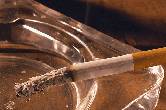
MONDAY, May 14 (HealthDay News) — For nonsmokers, exposure to low levels of secondhand smoke for just 30 minutes can cause significant damage to the lining of their blood vessels, the results of a new study indicate.
The findings could have major public health implications because this type of damage has been associated with atherosclerosis (hardening of the arteries), which can lead to heart attack or stroke.
“Breathing in very low levels of secondhand smoke — the same amount many people and children would encounter out and about in the community — appears to impair one’s vascular function after just 30 minutes of exposure,” the study’s lead investigator, Dr. Paul Frey, of the division of cardiology at San Francisco General Hospital, said in a news release from the American College of Cardiology.
“These findings have significant public health implications,” Frey added. “We saw a steep decline in vascular function even after a very short exposure to low levels of secondhand smoke, and that’s very concerning.”
The researchers used a smoking machine to produce specific particulate concentrations and measured its effects on 33 healthy nonsmokers ranging in age from 18 to 40 years old. The nonsmokers were divided into three groups and exposed to one of three levels of secondhand smoke: clean air; lower levels of lingering smoke found in smokers’ homes or a restaurant; and high levels found in a smoky bar or casino.
“We were able to faithfully characterize the concentration of secondhand smoke people were exposed to and produce very low levels that have not often been studied,” Frey explained.
The study, published in the May 22 issue of the Journal of the American College of Cardiology, revealed that a major blood vessel found in the upper arm, called the brachial artery, did not dilate properly in the people exposed to lingering secondhand smoke. This happened, the authors explained, because the inner lining of the blood vessels was not working properly.
The investigators noted that the effect on the participants’ cardiovascular function may have been greater if the study repeated short exposure rather than measure a one-time interval. Repeated exposure would also more closely resemble everyday life, they pointed out in the news release.
The researchers concluded that more comprehensive policies are needed to ban public smoking. They also suggested that doctors should talk to their patients about whether or not they live with a smoker or are occasionally around or near people who smoke.
“Smoking remains one of the most preventable risk factors for cardiovascular disease,” Frey said. “We hope this study will reinforce to smokers the danger their habit has — not only on their own heart health, but also to other people — even if they move to the next room or smoke for short durations.”
Although the study uncovered an association between secondhand smoke and blood vessel damage, it did not prove a cause-and-effect relationship.
More information
The U.S. Centers for Disease Control and Prevention has more about secondhand smoke .

